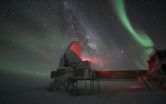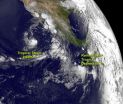(Press-News.org) A National Science Foundation-funded radio telescope in Antarctica has found an extraordinary galaxy cluster that may force astronomers to rethink how galaxy clusters and the galaxies that inhabit them evolve.
The galaxy cluster was discovered some 5.7 billion light years from Earth by the 10-meter wide South Pole Telescope (SPT) located at NSF's Amundsen-Scott South Pole Station in Antarctica, which is funded by NSF's Office of Polar Programs.
NSF manages the U.S. Antarctic Program, through which it coordinates all U.S research and required logistical support on the continent as well as aboard ships in the Southern Ocean.
Officially known as SPT-CLJ2344-4243, the cluster has been dubbed the "Phoenix Cluster" because it is located in the constellation of the Phoenix and because of its remarkable properties. Scientists taking part in the SPT collaboration found the cluster using the Sunyaev-Zel'dovich (SZ) effect, the result of high energy electrons distorting the cosmic microwave background (CMB) radiation through inverse Compton scattering, in which the low energy CMB photons receive an average energy boost during collision with the high energy cluster electrons.
Galaxy clusters, which are among the largest objects in the universe, contain enough hot gas to create detectable "shadows" in the light left over from the Big Bang, which also is known as CMB radiation.
"The mythology of the Phoenix--a bird rising from the dead--is a perfect way to describe this revived object," said Michael McDonald, a Hubble Fellow at the Massachusetts Institute of Technology and the lead author of a paper appearing in the August 16 issue of the journal Nature. "While galaxies at the center of most clusters have been dead for billions of years, the central galaxy in this cluster seems to have come back to life."
Observations made by NASA's Chandra X-ray Observatory in space and by the NSF-managed Gemini Observatory and the Blanco 4-meter and Magellan telescopes in Chile corroborate the SPT discovery and show that stars are forming in this object at the highest rate ever seen in the middle of a galaxy cluster. The object also is the most powerful producer of X-rays of any known cluster, and among the most massive of clusters. The data also suggest that the rate of hot gas cooling in the central regions of the cluster is the largest ever observed.
This light has travelled for 14 billion years across the entire observable universe to get to Earth. If it passes through a massive cluster on its way, then a tiny fraction of the light gets scattered to higher energies--the SZ effect.
Predicted in 1972, the SZ effect was first demonstrated to detect previously unknown clusters of galaxies by the SPT collaboration in 2009. Observations of the effect have since opened a new window for astronomers to discover the most massive, distant clusters in the universe.
"The beauty of the SZ effect for cosmology is that it is as easy to detect a cluster of galaxies in the distant reaches of the observable universe as it is for one nearby," said John Carlstrom, the S. Chandrasekhar Distinguished Service Professor in Astronomy & Astrophysics at the University of Chicago and the SPT's principal investigator. "The magnitude of the effect depends on the mass of the object and not its distance from Earth."
Like other galaxy clusters, Phoenix contains a vast reservoir of hot gas, containing more normal matter than all of the galaxies in the cluster combined. The emission from this reservoir can only be detected with X-ray telescopes like NASA's Chandra X-ray Observatory. The prevailing wisdom had once been that this hot gas should cool over time and sink to the center of the cluster, forming huge numbers of stars.
However, central galaxies in the cluster have formed very few stars over the last few billion years. Astronomers think that the super-massive black hole in the central galaxy of a cluster pumps energy into the system, preventing cooling of gas from causing a burst of star formation. The famous Perseus Cluster is an example of a black hole bellowing out energy and preventing the gas from cooling to form stars at a high rate.
With the black hole not producing powerful enough jets to halt cooling, the center of the Phoenix cluster is buzzing with stars that are forming 20 times faster than in the Perseus Cluster. This rate is the highest seen in the center of a galaxy cluster and is comparable to the highest seen anywhere in the universe.
The frenetic pace of star birth and cooling of gas in Phoenix are causing both the galaxy and the black hole to add mass very quickly--an important phase that the researchers predict will be relatively short-lived.
"The galaxy and its black hole are undergoing unsustainable growth," said co-author Bradford Benson, of the University of Chicago. "This growth spurt can't last longer than about a hundred million years; otherwise the galaxy and black hole would become much bigger than their counterparts in the nearby universe."
Remarkably, the Phoenix Cluster and its central galaxy and super-massive black hole are already among the most massive known objects of their type. Because of their tremendous size, galaxy clusters are crucial objects for studying cosmology and galaxy evolution, so finding one with such extreme properties as the Phoenix Cluster is significant.
The SPT collaboration has now completed an SZ survey of the 2500 square degrees of the southern sky that began in February 2007. It has found approximately 500 "SZ effect" galaxy clusters and published more than 20 papers in peer-reviewed journals. Further analysis of the collected data could reveal the existence of additional galaxy clusters.
INFORMATION:
The NSF-funded Physics Frontier Center of the University of Chicago's Kavli Institute for Cosmological Physics, the Department of Energy's Argonne National Laboratory, the Kavli Foundation, and the Gordon and Betty Moore Foundation also provide partial support for the SPT.
NSF's South Pole Telescope discovers a galaxy cluster creating stars at a record pace
Researchers say Phoenix Cluster activity may cause scientists to rethink how galaxies evolve
2012-08-16
ELSE PRESS RELEASES FROM THIS DATE:
Lunar reconnaissance orbiter spectrometer detects helium in moon's atmosphere
2012-08-16
Scientists using the Lyman Alpha Mapping Project (LAMP) spectrometer aboard NASA's Lunar Reconnaissance Orbiter (LRO) have made the first spectroscopic observations of the noble gas helium in the tenuous atmosphere surrounding the Moon.
These remote-sensing observations complement in situ measurements taken in 1972 by the Lunar Atmosphere Composition Experiment (LACE) deployed by Apollo 17.
Although designed to map the lunar surface, the LAMP team expanded its science investigation to examine the far ultraviolet emissions visible in the tenuous atmosphere above the ...
NASA sees large Tropical Storm Kai-tak headed for a landfall near Hong Kong
2012-08-16
Warnings are still in effect in the northern Philippines and now in Hong Kong, as Tropical Storm Kai-tak continues to drop heavy rainfall and move toward a landfall in China. NASA's Aqua satellite captured infrared data that shows a large area of strong thunderstorms that make up Kai-tak.
NASA's Aqua satellite captured infrared data on Kai-tak when it passed overhead on August 15 at 0517 UTC (1:17 a.m. EDT/1:17 p.m. local time, Hong Kong). Forecasters at the Joint Typhoon Warning Center noted that infrared satellite imagery shows the organization near the center of Kai-tak's ...
Lunar Reconnaissance Orbiter's LAMP spectrometer detects helium in moon's atmosphere
2012-08-16
Scientists using the Lyman Alpha Mapping Project (LAMP) aboard NASA's Lunar Reconnaissance Orbiter have made the first spectroscopic observations of the noble gas helium in the tenuous atmosphere surrounding the Moon. These remote-sensing observations complement in-situ measurements taken in 1972 by the Lunar Atmosphere Composition Experiment (LACE) deployed by Apollo 17.
Although LAMP was designed to map the lunar surface, the team expanded its science investigation to examine the far ultraviolet emissions visible in the tenuous atmosphere above the lunar surface, detecting ...
GOES-15 satellite sees fading Tropical Storm Hector and TD7's remnants
2012-08-16
Two tropical cyclones were spotted from NOAA's GOES-15 satellite today, August 15. Tropical Storm Hector continues to weaken in the Eastern Pacific Ocean, while the remnants of the Atlantic Ocean's Tropical Depression 7 are moving over Central America. NASA's GOES Project, located at NASA's Goddard Space Flight Center, Greenbelt, Md., uses the GOES-15 satellite data to create images and animations from the satellite. The NOAA GOES-15 satellite sits in a fixed orbit over the eastern U.S. and provides infrared and visible imagery of the Eastern Pacific Ocean basin continuously. ...
Continuous oral contraceptive pills offer women earlier pain relief
2012-08-16
Taking oral contraceptives continuously, rather than as traditionally prescribed for each cycle, provides earlier relief for moderate to severe menstrual cramps -- dysmenorrhea -- according to researchers at Penn State College of Medicine.
Dysmenorrhea occurs during menstruation, resulting from abnormal uterine contractions, increased sensitivity to pain and added pressure in the pelvic area. It is often accompanied by nausea, vomiting, diarrhea, headache and fatigue.
"Between 50 and 90 percent of women suffer from this condition, and it can really limit work, school, ...
Astronomers reassured by record-breaking star formation in huge galaxy cluster
2012-08-16
This press release is available in Spanish.
Until now, evidence for what astronomers suspect happens at the cores of the largest galaxy clusters has been uncomfortably scarce. Theory predicts that cooling flows of gas should sink toward the cluster's center, sparking extreme star formation there, but so far – nada, zilch, not-so-much.
The situation changed dramatically when a large international team of over 80 astronomers, led by Massachusetts Institute of Technology's Hubble Fellow Michael McDonald, studied a recently discovered (yet among the largest-known) galaxy ...
Divorced couples' co-parenting relationships can improve, MU researcher says
2012-08-16
COLUMBIA, Mo. – New research conducted at the University of Missouri offers hope for divorced parents and suggests hostile relationships can improve when ex-spouses set aside their differences and focus on their children's needs.
"Most people falsely believe that, when people get divorced, they'll continue to fight, to be hostile," said Marilyn Coleman, Curators' Professor of Human Development and Family Studies at MU. "We found in our study that's not always true. Some couples get along from the very beginning, and, for about half of the women we interviewed, the couples ...
Tracking the effects of prenatal alcohol exposure through to 9 years of age
2012-08-16
Although studies of alcohol's effects on fetal growth have consistently demonstrated deficits that persist through infancy, the data on long-term postnatal growth from human studies have been inconsistent. A new study of the effects of heavy prenatal alcohol exposure (PAE) on growth and body composition throughout childhood has found growth restrictions that persist through to nine years of age, as well as a delay in weight gain during infancy, both of which were exacerbated by iron deficiency.
Results will be published in the November 2012 issue of Alcoholism: Clinical ...
Climate change effects, potential mitigation in Northeast forests subject of Forest Service Report
2012-08-16
DURHAM, N.H., August 15, 2012 – A new report by U.S. and Canadian scientists analyzes decades of research and concludes that the climate of the Northeast has changed and is likely to change more. The report outlines the effects of climate change on multiple aspects of forests in the northeastern corner of the United States and eastern Canada and concludes with recommendations on adaptive and mitigating strategies for dealing with future effects.
The report, "Changing Climate, Changing Forests: The impacts of climate change on forests of the northeastern United States and ...
Children's self-control is associated with their body mass index as adults
2012-08-16
Cincinnati, OH, August 16, 2012 – As adults, we know that self-control and delaying gratification are important for making healthful eating choices, portion control, and maintaining a healthy weight. However, exhibiting these skills at a young age actually may affect weight later in life. A new study scheduled for publication in The Journal of Pediatrics finds that delaying gratification longer at 4 years of age is associated with having a lower body mass index (BMI) 30 years later.
Between 1968 and 1974, 653 4-year-olds completed a delay of gratification test, in which ...
LAST 30 PRESS RELEASES:
New species of tiny pumpkin toadlet discovered in Brazil highlights need for conservation in the mountain forests of Serra do Quiriri
Reciprocity matters--people were more supportive of climate policies in their country if they believed other countries were making significant efforts themselves
Stanford Medicine study shows why mRNA-based COVID-19 vaccines can cause myocarditis
Biobanking opens new windows into human evolution
Sky-high smoke
AI tips off scientists to new drug target to fight, treat mpox
USC researchers develop next-generation CAR T cells that show stronger, safer response in animal models
New study reveals Industrial Revolution’s uneven health impacts across England
Vine-inspired robotic gripper gently lifts heavy and fragile objects
Fingerprint of ancient seafarer found on Scandinavia’s oldest plank boat
Lunar soil analyses reveal how space weathering shapes the Moon’s ultraviolet reflectance
Einstein’s theory comes wrapped up with a bow: astronomers spot star “wobbling” around black hole
Danforth Plant Science Center to lead multi-disciplinary research to enhance stress resilience in bioenergy sorghum
Home-delivered groceries improve blood sugar control for people with diabetes facing food insecurity
MIT researchers identified three cognitive skills we use to infer what someone really means
The Iberian Peninsula is rotating clockwise according to new geodynamic data
SwRI, Trinity University to study stable bacterial proteins in search of medical advances
NIH-led study reveals role of mobile DNA elements in lung cancer progression
Stanford Medicine-led study identifies immune switch critical to autoimmunity, cancer
Research Alert: How the Immune System Stalls Weight Loss
Glucagon-like peptide 1 receptor agonist use and vertebral fracture risk in type 2 diabetes
Nonadherence to cervical cancer screening guidelines in commercially insured US adults
Contraception and castration linked to longer lifespan
An old jeweler’s trick could unlock next-generation nuclear clocks
Older age, chronic kidney disease and cerebrovascular disease linked with increased risk for paralysis and death after West Nile virus infection
New immune role discovered for specialized gut cells linked to celiac disease
A new ‘hypertropical’ climate is emerging in the Amazon
Integrated piezoelectric vibration and in situ force sensing for low-trauma tissue penetration
Three-hit model describes the causes of autism
Beech trees use seasonal soil moisture to optimize water uptake
[Press-News.org] NSF's South Pole Telescope discovers a galaxy cluster creating stars at a record paceResearchers say Phoenix Cluster activity may cause scientists to rethink how galaxies evolve




